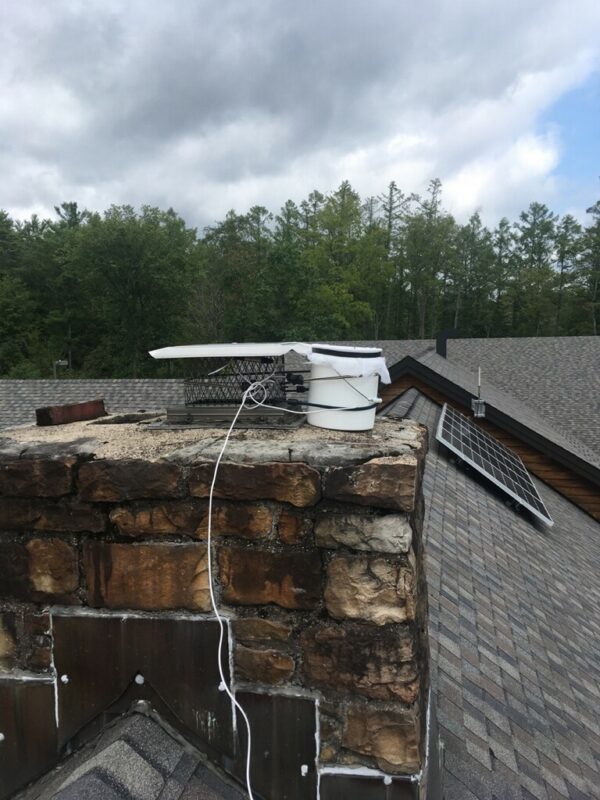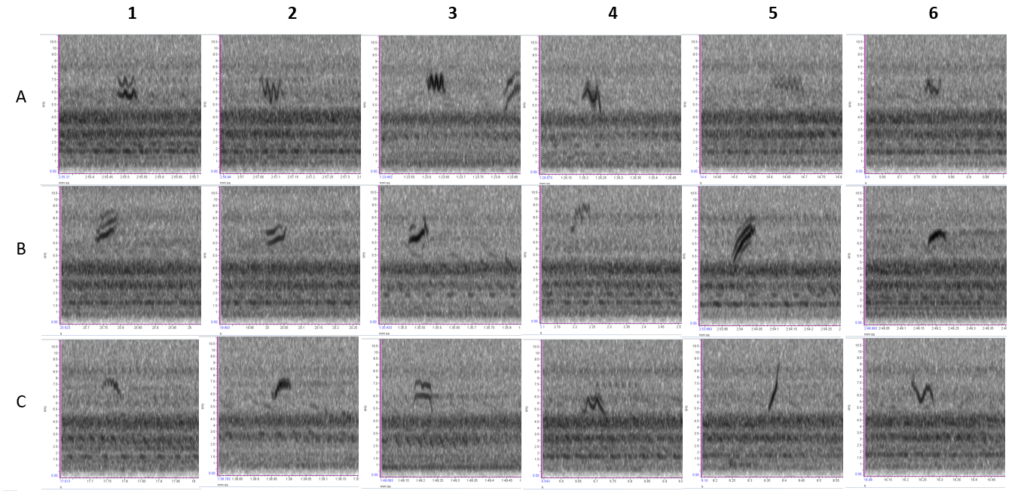
A little plastic bucket sat on the roof of the Center this September and October, holding a microphone pointed at the sky. Nocturnal sounds were recorded to contribute to an Appalachian-wide study of fall bird migration run by Cornell Laboratory of Ornithology researcher Benjamin Van Doren. This week, I took a first look and listened to the sounds recorded between midnight and 6:00 a.m. on September 17 and found it was a pretty busy night, with 689 bird calls in total.
With the Flight Calls of Migratory Birds: Eastern North American Landbirds by Bill Evans and Michael O’Brien, the Peterson’s Field Guide to Bird Sounds by Nathan Pieplow, and lots of help from other nocturnal flight call fans on a Facebook group, I’ve become fairly confident with identifying many common calls we get at night in Pennsylvania, although hardly an hour goes by without a few head-scratchers in the mix. Also, because many species give similar calls, some are simply unresolvable. I was only able to identify 35% of the calls to species.
About 356 of the calls were unidentified warblers. This night, more than half of these unidentified warblers were the ones we call “zeeps” (a group mostly composed of Blackpoll, Magnolia, and Blackburnian Warblers at this time of year), with the rest being “double ups” (mostly Black-throated Green, Nashville, and Tennessee Warblers) and assorted other warbler call types (mostly Yellow-rumped, perhaps some Palm variants, Prairie, and more). Because warbler calls are so short (mostly 1/20th to 1/10th of a second), the easiest way for me to identify them is by making spectrograms and sort of reading the sheet music, checking the signatures that the quick little sounds make in the soundscape.

The video below shows a recording of three “zeep” warbler calls between 5 and 19 seconds into the video, and then at 20 seconds, there is an uncommon call type detected, suspected to be a Mourning Warbler.
Among the 238 calls that I decided I could attribute to a species, almost half were Swainson’s Thrushes, which give a spring peeper-like “wee” call as they zoom overhead. The aural abundance of this olive-backed thrush is expected in this part of fall migration (and much of spring migration) in Pennsylvania. A huge number of them nest in the boreal forests to our north and winter in tropical rainforests as far south as the mountains of Argentina. As they pass through our region, they are exceptionally vocal in flight. It’s very challenging to decide how many different birds are producing the calls, especially when there seem to be several birds peeping together, but suffice to say that as far as I could hear, it was the species leader for the night.
More surprising was the number of Black-throated Blue Warbler calls noted, with 34 call notes, attributed to perhaps 25 different birds, putting them in second place for call note abundance. Analyzing other nights of recordings at my house in State College, I don’t recall ever getting so many of these guys, with their super short rising call notes. More often, I get tons of Ovenbirds, which was the third most common caller with 23 call notes identified. They also have a high rising call, but it is longer, slurs flat, and becomes burry at the end of the spectrogram. Fourth place was Cape May Warbler with 15 calls. This sharply descending call is a bit like the zeeps, but doesn’t have very deep vibrations between the top and bottom of each wave in the call note.
In the medium abundance range with 7–12 call notes recorded, we had Rose-breasted Grosbeak (which can be hard to identify and maybe quite a few more of these were left as unidentified passerines), Savannah Sparrow (another surprisingly abundant and vocal migrant that many people don’t see much during the day, even though it chirps often over your house at night), Bay-breasted Warbler, and American Redstart. Finally, the species that had 3 or fewer call notes were Spotted Sandpiper, Gray-cheeked Thrush, Veery, Chipping Sparrow, Chestnut-sided Warbler, Northern Parula, Mourning Warbler, Palm Warbler, Black-and-white Warbler, Wilson’s Warbler, and Indigo Bunting. The rarest bird detected, a big surprise just before the 6:00 a.m. cutoff, was the single nasal croaking bark of a Least Bittern.
Finally, there were some high pitched chittery noises that I expect were the sounds of Southern Flying Squirrels. To my knowledge, there is no field guide to the nocturnal sounds of small mammals, so it’s hard to rule out other little mammals for certain! For me, one of the most exciting things about nocturnal sound recording is the ever present possibility to record calls that are still somewhat unknown to science, whether they be different variants of bird or mammal calls. Surely I’ve made a few mistakes in the tallies above, and it’s a repeatedly humbling endeavor to try to learn these sounds, but for wildlife listers like me, it’s a lot of fun to listen to the night’s surprises. Hopefully in the future as it becomes easier to identify calls with machine learning systems, Shaver’s Creek will be able to contribute to an ongoing network of flight call monitoring stations tracking each season’s bird migration as it happens.
eBird Checklists by Hour
eBird checklist from 12:00 a.m., Saturday, September 17.
eBird checklist from 1:00 a.m., Saturday, September 17.
eBird checklist from 2:00 a.m., Saturday, September 17, featuring Bay-breasted Warbler and Wilson’s Warbler calls.
eBird checklist from 3:00 a.m., Saturday, September 17, featuring Black-throated Blue Warbler calls.
eBird checklist from 4:00 a.m., Saturday, September 17, featuring American Redstart calls.
eBird checklist from 5:00 a.m., Saturday, September 17, featuring Swainson’s Thrush and Least Bittern calls.
iNaturalist Recordings of Suspected Flying Squirrels
iNaturalist recording from 4:21 a.m., Saturday, September 17
iNaturalist recording from 4:24 a.m., Saturday, September 17
